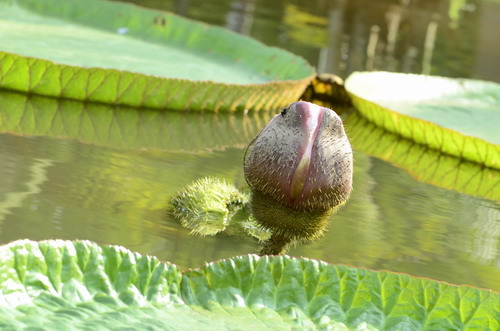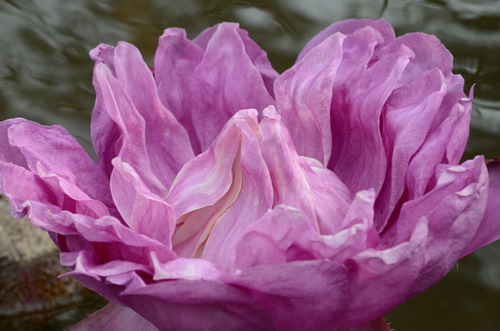King lotus (Victoria amazonica) is native to the shallow waters of the Amazon River basin. It is big and beautiful and the color of the flowers changes with time. The flowers are white the first night they are open and become pink the second night. (The initial blossoms are white. In the dawn next day, the petals contract into a bud. In the dusk, the flowers loom again with rosy petals.) Most amazingly, the leaf of Victoria is able to support quite a large weight due to the plant's structure. It can support / bear up to 50-70 kiligrams.

The bud and leaves of the king lotus

The open flower

Flower in full blossom (Images taken in XTBG)
Victoria amazonica is well known for its huge circular leaves, which are often pictured with a small child sitting supported in the centre as a demonstration of their size and strength. The species is highly prized as an ornamental, despite having somewhat particular requirements for successful cultivation.
Native to tropical South America, Victoria amazonica was first discovered in Bolivia in 1801 and named Eurgale amazonica. It was subsequently moved to a new genus named in honour of Queen Victoria (originally as Victoria regia). In South America it grows in the backwaters of rivers in the Amazon basin, the Guianas and the Pantanal.
The enormous circular leaves, which grow to over 2.5 m across, have upturned rims and are anchored by long stalks arising from an underground stem buried in the mud of the river bottom. The leaves first appear as spiny heads but expand rapidly up to half a square metre per day. The upper surface has a rather quilted appearance and a waxy layer that repels water. The purplish red undersurface has a network of ribs clad in abundant sharp spines, possibly a defence against herbivorous fishes and manatees. Air trapped in the spaces between the ribs enables the leaves to float. They are so buoyant that they can easily support the weight of a small child, and a mature leaf can support 45 kg if the load is evenly distributed. In a single season, each plant produces some 40 to 50 leaves, which cover the water surface and exclude light, thus restricting the growth of most other plants.



